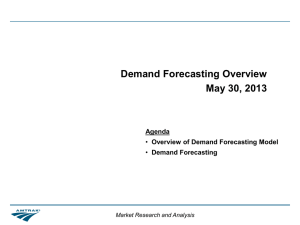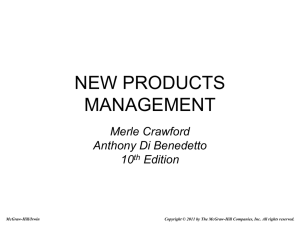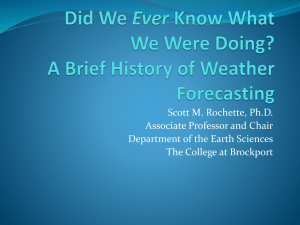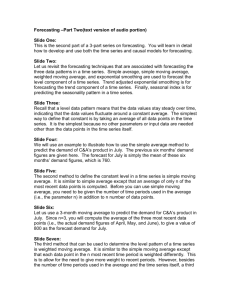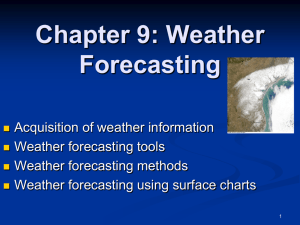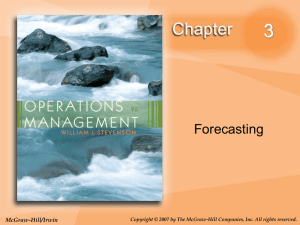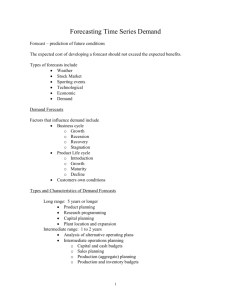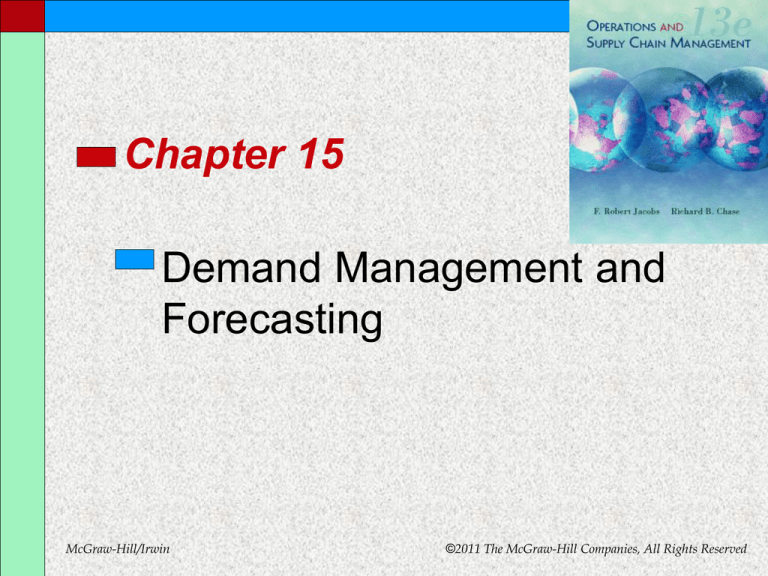
Chapter 15
Demand Management and
Forecasting
McGraw-Hill/Irwin
©2011 The McGraw-Hill Companies, All Rights Reserved
Learning Objectives
Understand the role of forecasting as a basis for
supply chain planning.
Compare the differences between independent and
dependent demand.
Identify the basic components of independent
demand: average, trend, seasonal, and random
variation.
Describe the common qualitative forecasting
techniques such as the Delphi method and
Collaborative Forecasting.
Show how to make a time series forecast using
regression, moving averages, and exponential
smoothing.
Use decomposition to forecast when trend and
seasonality is present.
15-2
Characteristics of Forecasts
Guessing at the future: educated guessing game
Seldom correct
No perfect forecast
Objective is to minimize forecast errors
It is only a tool used to set:
Production plan and budgets
Work schedules
Forecasts are more accurate in aggregation
Long-term forecasts are less accurate than
short-term forecasts
Forecasts are means to an end
15-3
Demand Management
Strategic forecasts: forecasts used to help
set the strategy of how demand will be met
Tactical forecasts: forecasted needed for
how a firm operates processes on a day-today basis
The purpose of demand management is to
coordinate and control all sources of demand
Two basic sources of demand
LO 2
Dependent demand: the demand for a product or
service caused by the demand for other products or
services
Independent demand: the demand for a product or
service that cannot be derived directly from that of
other products
15-4
Demand Management
Continued
Not much a firm can do about
dependent demand
It is demand that must be met
There is a lot a firm can do about
independent demand
Take an active role to influence demand
Offer incentive to customers
Wage campaigns to sell products
Take a passive role and respond to demand
Especially if at full capacity
High cost of advertisement
LO 1
15-5
Types of Forecasts
Basic types of forecasts
Quantitative—use historical data
Time series analysis
Causal relationships
Simulation
Qualitative—based on subjective estimates/opinion
Time series analysis is based on the
idea that data relating to past demand
can be used to predict future demand
Primary focus of this chapter
LO 1
15-6
Components of Demand
Average demand for a period of
time
Trend
Seasonal element
Cyclical elements
Random variation
Autocorrelation
LO 3
15-7
Common Types of Trends
LO 3
15-8
Time Series Analysis
Short term: forecast under three
months
Tactical decisions
Medium term: three months to two
years
Capturing seasonal effects
Long term: forecast longer than two
years
Detecting general trends
Identifying major turning points
LO 5
15-9
A Guide to Selecting an
Appropriate Forecasting Method
LO 5
15-10
Pick Forecasting Model
Based On
Time horizon to forecast
Data availability
Accuracy required
Size of forecasting budget
Availability of qualified personnel
LO 5
15-11
Linear Regression Analysis
TC FC VC
TC 80000 75 X
Regression: functional relationship
between two or more correlated
variables
It is used to predict one variable given
the other
Y = a + bX
LO 5
Y is the value of the dependent variable
a is the Y intercept
b is the slope
X is the independent variable
Assumes data falls in a straight line
15-12
Example 15.1: The Data and
Least Squares Regression Line
LO 5
15-13
Example 15.1: Equations
and Calculating Totals
LO 5
15-14
Example 15.1:
Calculating the Forecast
Y a bx
Y13 441.6 359.614 5,116.4
Y14 441.6 359.615 5,476.0
Y15 441.6 359.616 5,835.6
Y16 441.6 359.617 6,195.2
LO 5
15-15
Calculating the Forecast
180
Week
Sales
Forecast
175
170
Y = 143.5 + 6.3x
Sales
165
What is forecast for x=100?
160
Y = 143.5 + 6.3(100)
= 774
155
150
145
1
2
3
4
5
Week
15-16
Decomposition
of a Time Series
Time series: chronologically ordered
data that may contain one or more
components of demand
Decomposition: identifying and
separating the time series data into
these components
Seasonal variation
Additive: the seasonal amount is constant
Multiplicative: the seasonal variation is a
percentage of demand
LO 6
15-17
Additive and Multiplicative Seasonal
Variation Superimposed on Changing Trend
LO 6
15-18
Example 15.3:
The Data and Hand Fitting
Y a bx
170 55x
LO 6
15-19
Example 15.3: Computing Seasonal
Factors and Computing Forecast
LO 5
15-20
Decomposition Using Least
Squares Regression
Determine the seasonal factor
Deseasonalize the original data
Develop a least squares regression line
for the deseasonalized data
Project the regression line through the
period of the forecast
Create the final forecast by adjusting the
regression line by the seasonal factor
LO 6
15-21
Steps 1-3
Deseasonalized Demand
LO 6
15-22
Steps 4 – 5
LO 6
15-23
Simple Moving Average
Useful when demand is neither growing
nor declining rapidly and does not have
seasonal characteristics
Moving averages can be centered or
used to predict the following period
Important to select the best period
Longer gives more smoothing/less sensitive
Shorter reacts quicker to trends
LO 5
15-24
Simple Moving Average
Formula
At 1 At 2 At 3 At n
Ft
n
Ft Forecastfor thecomingperiod
n Number of periods to be averaged
At 1 Actualoccurrencein t hepast period
At 2 , At 3 and At n Actualoccurrences two periodsago, three
periodsago, and so on up to n periodsago
LO 5
15-25
Forecast Demand Based on a Three- and
a Nine-Week Simple Moving Average
LO 5
15-26
Forecast Demand Based on a Three- and
a Nine-Week Simple Moving Average
15-27
Weighted Moving Average
The moving average formula implies an
equal weight being placed on each value
that is being averaged
The weighted moving average permits an
unequal weighting on prior time periods
All the weights must sum to one if fractions
Otherwise, weights can be real numbers. If so
divide by sum of weights:
Ft = wi Dt 1 / wi
Ft = w 1 A t-1 + w 2 A t- 2 + w 3 A t-3 +...+w n A t- n
LO 5
15-28
WMA Example
Question: Given the weekly demand information and
weights of 0.6, 0.1, and 0.3, what is the weighted moving
average forecast for the 5th period or week?
Week Demand
1
820
2
775
3
680
4
655
F5 = (0.6)(655)+(0.1)(680)+(0.3)(755)= 688
15-29
Choosing Weights
Experience and trial-and-error are the
simplest ways
Generally, the most recent past is the
best indicator
When data are seasonal, weights
should be established accordingly
LO 5
15-30
Exponential Smoothing
Most used of all forecasting techniques
Integral part of all computerized
forecasting programs
Widely used in retail and service
Widely accepted because…
Exponential models are surprisingly accurate
Formulating an exponential model is relatively easy
The user can understand how the model works
Little computation is required to use the model
Computer storage requirements are small
Tests for accuracy are easy to compute
LO 5
15-31
Exponential Smoothing
Model
Ft = Ft-1 +(At-1 - Ft-1)
Where:
Ft = Forecast value for the coming t time period
Ft 1 = Forecast value in 1 past time period
At 1 = Actual occurrence in the past 1 time period
= Alpha smoothing constant
Premise: The most recent observations might have the
highest predictive value
Therefore, we should give more weight to the more
recent time periods when forecasting
LO 5
15-32
Exponential Smoothing
Example (=0.20)
LO 5
Week
1
2
3
4
5
6
7
8
9
10
Demand
820
775
680
655
750
802
798
689
775
0.2
820.00
820.00
811.00
784.80
758.84
757.07
766.06
772.45
755.76
759.61
820 0.2820 820
820 0.20 820
820 0.2775 820
820 0.2 45
820 9.0 811
811 .2680 811
811 .2 131
811 26.2 784.8
15-33
ES Example (=0.10, 0.60)
Week
1
2
3
4
5
6
7
8
9
10
Demand
820
775
680
655
750
802
798
689
775
0.1
0.6
820.00
820.00
815.50
801.95
787.26
783.53
785.38
786.64
776.88
776.69
820.00
820.00
793.00
725.20
683.08
723.23
770.49
787.00
728.20
756.28
15-34
ES Example (=0.10, 0.60)
850
Note how the smaller alpha results in a smoother line in this example
800
Demand
750
700
Demand
650
Alpha=0.1
Alpha=0.6
600
1
2
3
4
5
6
7
8
9
10
Week
15-35
Trend Effects in
Exponential Smoothing
An trend in data causes the
exponential forecast to always lag the
actual data
Can be corrected somewhat by adding
in a trend adjustment
To correct the trend, we need two
smoothing constants
Smoothing constant alpha ()
Trend smoothing constant delta (δ)
LO 5
15-36
Exponential Forecasts versus
Actual Demand over Time Showing
the Forecast Lag
LO 5
15-37
Trend Effects Equations
FITt Ft Tt
Ft FITt 1 At 1 FITt 1
Tt Tt 1 Ft FITt 1
Ft T heexponentially smoothedforecastfor period t
Tt T heexponentially smoothedtrendfor period t
FITt T heforecastincluding trendfor period t
FITt -1 T heforecastincluding trendmade for theprior period
A t -1 T heactualdemandfor theprior period
LO 5
Smoothingconstant
Smoothingconstant
15-38
Forecast Error
Sources of errors
Projecting the past into the future
Wrong relationships
Wrong information (data)
Errors outside of our control
Goal is to minimize the errors
15-39
Forecast Error
Bias errors: when a consistent
mistake is made
Random errors: errors that cannot be
explained by the forecast model being
used
Measures of error
Mean absolute deviation (MAD)
Mean absolute percent error (MAPE)
Tracking signal
LO 5
15-40
The MAD Statistic to
Determine Forecasting Error
The ideal MAD is zero which would
mean there is no forecasting error
The larger the MAD, the less the
accurate the resulting model
n
A
MAD =
t
t=1
n
- Ft
1 MAD 0.8 standard deviation
1 standard deviation 1.25 MAD
LO 5
15-41
Example: Find the MAD
Month Sales
1
220
2
250
3
210
4
300
5
325
Forecast Abs Error
—
255
205
320
315
Total =
n
MAD =
A t - Ft
t=1
n
40
=
= 10
4
—
5
5
20
10
40
Note that by itself, the MAD
only lets us know the mean
error in a set of forecasts
15-42
Tracking Signal
The tracking signal (TS) is a measure that
indicates whether the forecast average is
keeping pace with any genuine upward or
downward changes in demand
Depending on the number of MAD’s
selected, the TS can be used like a quality
control chart indicating when the model is
generating too much error in its forecasts
RSFE Running sum of forecast errors
TS =
=
MAD
Mean absolute deviation
LO 5
15-43
Computing the MAD, the RSFE, and
the TS from Forecast and Actual Data
LO 5
15-44
Example: Tracking Signal
Period
Forecast
Demand
Error
|E|
RSFE
- 50
50
- 50
- 75
- 75
75
75
- 125
- 200
Sum
|E|
MAD
TS
50
125
50.0
62.5
-1
-2
66.7
62.5
-3
-4
1
2
250
325
200
250
3
4
400
350
325
300
- 50
50
- 250
200
250
5
375
325
- 50
50
- 300
300
60.0
-5
6
450
400
- 50
50
- 350
350
58.3
-6
+ 4
3
2
1
TS
0
- 1
- 2
Out of Control
- 3
- 4
- 5
- 6
1
2
3
4
5
6
Period
15-45
Causal Relationship
Forecasting
Causal relationship forecasting: using
independent variables other than time to
predict future demand
The independent variable must be a leading
indicator
Must find those occurrences that are
really the causes
LO 5
15-46
Qualitative Techniques in
Forecasting
Qualitative forecasting techniques take
advantage of the knowledge of experts
Most useful when the product is new or there is
little experience with selling into a new region
The following are samples of qualitative
forecasting techniques
LO 4
Executive judgment
Grass roots
Market research
Panel consensus
Historical analogy
Delphi method
15-47
Qualitative Methods
Executive Judgment
Grass Roots
• Used for new products introduction
• Decisions are broader and at a higher level
• Builds forecast by adding
successively from bottom
• Those closest to customer know
better
Market Research
Historical analogy
• Existing product used as model for
another
• Example: buying CDs on Internet put
you on mailing list for related products
Delphi Method
•
•
•
•
Based on expert opinion
Experts asked question anonymously
Goes thru several rounds of questioning
Results tabulated, iterated until a
consensus is reached
Qualitative
• Consumer surveys and interviews
• Used to improve existing products
Methods
Panel Consensus
• Open meetings with free exchange of
ideas
• Power play possibilities
15-48
Web-Based Forecasting:
(CPFR)
LO 5
Collaborative planning, forecasting, and
replenishment (CPFR): a Web-based tool used
to coordinate demand forecasting, production
and purchase planning, and inventory
replenishment between supply chain trading
partners
Used to integrate the multi-tier or n-Tier supply
chain
Objective is to exchange selected internal
information to provide for a reliable, longer term
future views of demand
CPFR uses a cyclic and iterative approach to
derive consensus forecasts
15-49
Web-Based Forecasting:
Steps in CPFR
Creation of a front-end partnership
agreement
Joint business planning
Development of demand forecasts
Sharing forecasts
Inventory replenishment
LO 5
15-50




